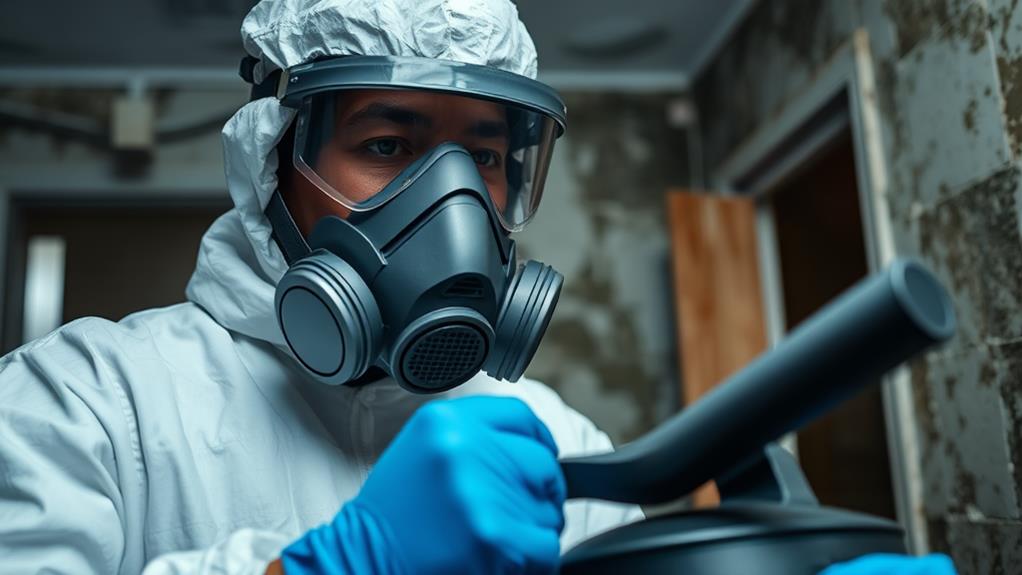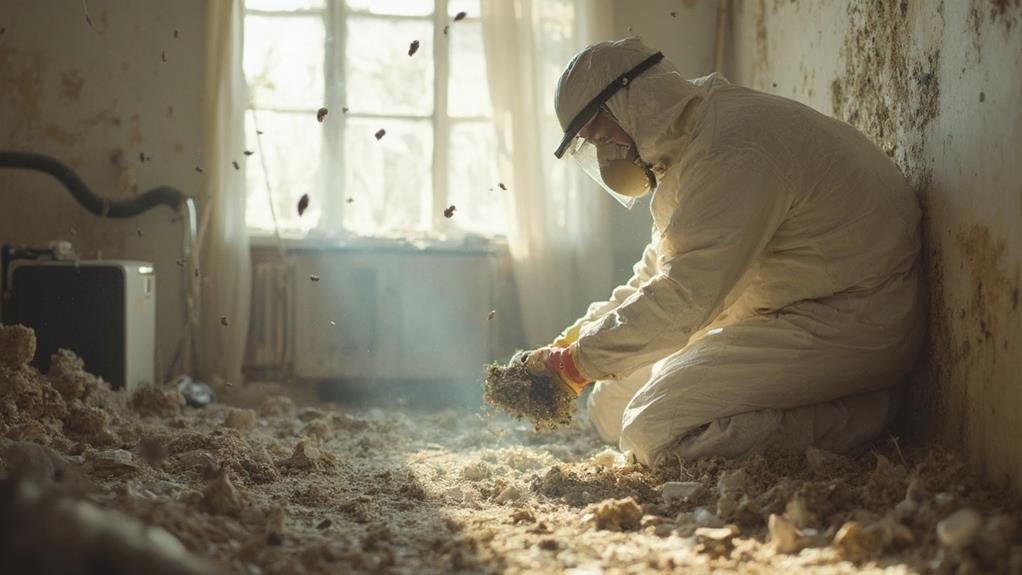Dealing with mold allergies during remediation requires a multi-faceted approach. Proper personal protective equipment, including respirators and protective clothing, is essential to minimize exposure. Air filtration and ventilation strategies, such as HEPA filters and negative air pressure machines, help control airborne spores. Managing symptoms with medications like antihistamines and nasal sprays can provide relief. In severe cases, temporary relocation may be necessary. Post-remediation cleaning with HEPA vacuums and antifungal solutions is crucial for maintaining a mold-free environment. By implementing these strategies, individuals can effectively navigate the remediation process while safeguarding their health. Further exploration of these methods can enhance your ability to cope with mold allergies during this challenging time.
Personal Protective Equipment Essentials

Invariably, proper personal protective equipment (PPE) is crucial when dealing with mold allergies. When undertaking mold remediation, individuals must prioritize their safety by utilizing appropriate protective gear. Essential PPE items include respirators, gloves, eye protection, and protective clothing.
Respirators are paramount in preventing the inhalation of mold spores and mycotoxins. N95 masks or higher-rated respirators effectively filter airborne particles. For more extensive mold infestations, full-face or powered air-purifying respirators may be necessary.
Disposable gloves, preferably made of nitrile or neoprene, protect the skin from direct contact with mold and cleaning agents. Goggles or safety glasses with side shields safeguard the eyes from debris and chemical splashes.
Protective clothing, such as disposable coveralls or long-sleeved shirts and pants, should be worn to prevent mold spores from adhering to clothing and skin. Disposable booties or dedicated work shoes help contain the spread of mold spores. After completing remediation work, all PPE should be carefully removed and disposed of or thoroughly cleaned to prevent cross-contamination. Regular maintenance and replacement of PPE ensure optimal protection throughout the mold remediation process.
Air Filtration and Ventilation Strategies
How can effective air filtration and ventilation strategies mitigate mold allergies? Proper air management is crucial in controlling mold spores and reducing allergy symptoms during remediation. High-efficiency particulate air (HEPA) filters are essential, as they can capture particles as small as 0.3 microns, including most mold spores. Portable HEPA air purifiers should be strategically placed in affected areas to continuously clean the air.
Negative air pressure machines are vital for larger remediation projects. These devices create a controlled airflow that prevents contaminated air from spreading to unaffected areas. They work by exhausting filtered air outside while drawing fresh air into the work zone. Dehumidifiers are also crucial in maintaining optimal humidity levels, typically between 30-50%, which inhibits mold growth.
Proper ventilation is equally important. Opening windows and using fans to promote air circulation can help disperse mold spores and reduce their concentration. However, this should be done carefully to avoid spreading contamination. In HVAC systems, installing high-quality filters and regularly cleaning ducts can significantly improve indoor air quality and reduce mold-related allergens throughout the building.
Medication and Symptom Management

Effectively managing mold allergy symptoms often involves a combination of medication and lifestyle adjustments. Over-the-counter antihistamines can provide relief from sneezing, runny nose, and itchy eyes. Decongestants may help alleviate nasal congestion, while nasal corticosteroid sprays can reduce inflammation and improve breathing.
For more severe cases, prescription medications like leukotriene modifiers or immunotherapy may be recommended by an allergist. Leukotriene modifiers block the action of certain immune system chemicals, while immunotherapy gradually desensitizes the body to mold allergens through controlled exposure.
In addition to medication, symptom management includes avoiding mold exposure whenever possible. During remediation, it's crucial to wear protective gear such as masks and gloves when entering affected areas. Regularly cleaning and drying surfaces prone to moisture accumulation can prevent mold growth. Using a dehumidifier to maintain indoor humidity levels below 50% can also help control mold proliferation.
For immediate relief, nasal irrigation with saline solution can flush out allergens and mucus. Staying hydrated and getting adequate rest support the body's natural defense mechanisms, aiding in symptom management and overall recovery from mold allergies.
Temporary Relocation Considerations
When mold allergies become severe or persistent, temporary relocation may be necessary to alleviate symptoms and facilitate remediation efforts. This decision should be made in consultation with healthcare providers and mold remediation experts. Factors to consider include the extent of mold contamination, the individual's sensitivity, and the expected duration of remediation.
Temporary housing options may include staying with family or friends, renting a short-term apartment, or booking an extended-stay hotel. Ensure the chosen location is mold-free and has good air quality. When relocating, take only essential items and clean them thoroughly to avoid transferring mold spores. Leave contaminated belongings behind for professional cleaning or disposal.
During relocation, maintain communication with remediation professionals to stay informed about the progress and expected completion date. Use this time to implement preventive measures for your return, such as purchasing air purifiers or dehumidifiers. Upon returning home, gradually reintroduce yourself to the environment, monitoring for any recurrence of symptoms. If allergic reactions persist, consult your healthcare provider to reassess the situation and consider additional remediation or long-term relocation options.
Post-Remediation Cleaning and Maintenance

The aftermath of mold remediation requires thorough cleaning and ongoing maintenance to prevent future infestations. Once the mold has been removed, it's crucial to clean all surfaces thoroughly, including walls, floors, and ceilings. Use HEPA-filtered vacuums to remove any remaining spores and debris.
Wash all fabrics, including curtains, bedding, and clothing, in hot water with antifungal detergents.
Disinfect hard surfaces with appropriate cleaning agents, such as diluted bleach or specialized mold-killing solutions. Pay special attention to areas prone to moisture, like bathrooms and kitchens. Replace any porous materials that were affected by mold, as they may harbor hidden spores.
To maintain a mold-free environment, control humidity levels using dehumidifiers and ensure proper ventilation throughout the home. Fix any leaks or water damage promptly. Regularly inspect areas prone to moisture accumulation and address issues immediately. Consider using mold-resistant paint and materials in high-risk areas. Implement a routine cleaning schedule, focusing on areas where mold typically thrives. By following these post-remediation practices, you can significantly reduce the risk of mold recurrence and alleviate allergy symptoms.
Frequently Asked Questions
How Long Does a Typical Mold Remediation Process Take?
The duration of a typical mold remediation process varies depending on the extent of the infestation and the affected area's size. Generally, it can take anywhere from 1 to 5 days for small-scale projects, and up to several weeks for larger ones.
Can Pets Be Affected by Mold Allergies During Remediation?
Like canaries in a coal mine, pets can indeed be affected by mold allergies during remediation. They may experience respiratory issues, skin irritation, or digestive problems. It's advisable to relocate pets during the process to ensure their safety and comfort.
Are Certain Types of Mold More Allergenic Than Others?
Yes, certain mold types are more allergenic than others. Particularly notorious are Alternaria, Aspergillus, Cladosporium, and Penicillium. These species tend to produce more potent allergens and are commonly found in indoor environments, potentially causing stronger allergic reactions in sensitive individuals.
How Soon After Remediation Can Allergy Symptoms Begin to Improve?
Allergy symptoms can begin to improve within days to weeks after proper mold remediation. However, individual responses vary, and some people may experience relief sooner, while others might take longer to notice significant improvements in their symptoms.
What's the Best Time of Year to Conduct Mold Remediation?
To remediate or not to remediate, that is the question. The best time for mold remediation is during dry, cool seasons—typically fall or winter. These conditions minimize moisture, slow mold growth, and facilitate effective treatment and drying processes.
Conclusion
As the final spores settle and the air clears, a transformed living space emerges from the mold remediation process. Like a forest after a cleansing rain, the environment stands renewed, free from allergens that once plagued its inhabitants. Vigilance remains key, with proper maintenance acting as a shield against future infestations. Through careful preparation, protection, and persistence, even those with sensitive respiratory systems can navigate the challenging terrain of mold remediation, emerging on the other side to breathe easier.

